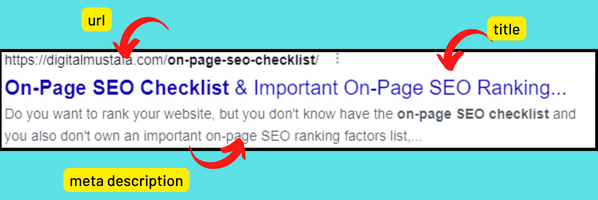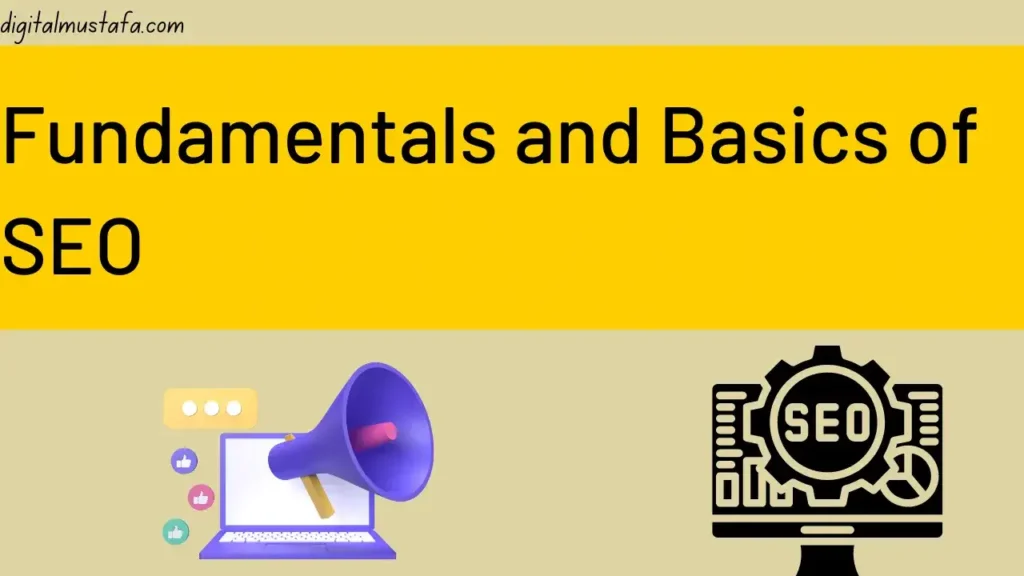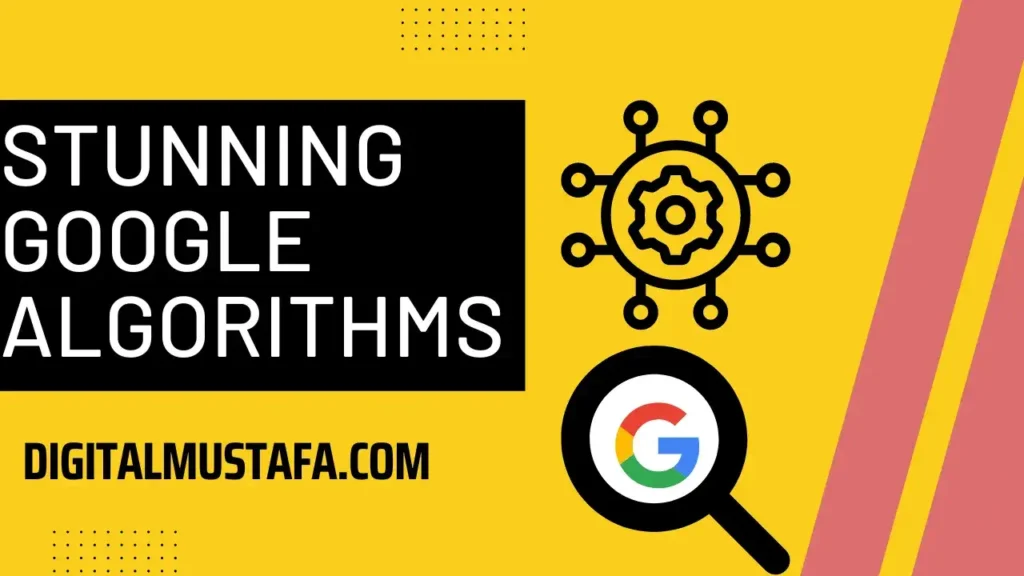Do you want to rank your website, but you don’t have the on-page SEO checklist and you also don’t own an important on-page SEO ranking factors list, don’t worry.
In this article, we will discuss some valuable on-page SEO ranking factors, which also include a small but an efficient on-page SEO checklist
What is On-Page SEO?
Before going to the important on-page SEO ranking factors list, I would like to introduce on-page SEO. So, What is On-Page SEO?
In simple words, whatever we optimize on our website, is part of On-Page SEO, like URL, Title, etc.
Also Read 👍: Fundamentals & Basics of SEO
Why On-Page SEO is Important?
On-Page SEO helps businesses to get organic traffic, which is free. On-Page SEO helps search engines easily crawl your website, and give you ranking. On-Page SEO is important for several reasons, but we are not going to discuss them because it is not our main topic. Our main aim is to cover all the important on-page SEO ranking factors and the on-page SEO checklists.
Important On-Page SEO Ranking Factors List

Let’s come to the on-page SEO factors. This is the list of on-page SEO ranking factors, which will help you optimize your content and get a chance to rank your website in google or other search engines.
Title Tag Optimization
Our, first important On-Page SEO Factor is Title Tag Optimization. Optimizing our Title in the right way is very helpful in various ways. It helps users to find what is in the content. It also helps search engines to index your web page in the right category.
Meta Description Optimization
On our important on-page SEO factor list, Meta Description Optimization stands on 2nd. The meta description is also important as the Title Optimization because, by the meta description, people decide whether to click or not. Meta description also do a big impact on SEO and rankings. To the new SEO updates, the meta description should not be more than 160 characters, which is 920px.

URL Optimization
URL Optimization plays a vital role in SEO. So we should not forget to optimize our URL.
Our URL should be short, not more than 5-6 Words. In these 5 words, our focus keyword should be displayed. And avoid using awkward URLs.
Examples of Wrong URL Slug:
- digitalmustafa.com/?p=123
- digitalmustafa.com/2022/09/13/sample-post/
Example of Correct URL Slug:
- digitalmustafa.com/fundamentals-of-seo (See, this URL is short, and it is covering my primary keyword)
Heading Tag Optimization
There are six heading tags (H1, H2, H3, H4, H5, and H6), but mostly used are H2 and H3, while H1 is used for title tags. Now it is important to optimize everything we can, on our website. Creating SEO-Friendly Headings is also important.
By seeing the Headings, the search engines are able to rank your web page, because headings define the structure of our content.
Internal And External Linking
Linking to internal and external resources is very important. Internal Linking means linking to your other articles or pages in your current article. Internal Linking is important because it can increase your page views, and decrease bounce rate, and the most important reason why internal links are important is that whenever a search engine’s crawler will come to crawl your XYZ blog post, it will also crawl your other pages which you have linked in the XYZ article.
External Links are links in your content, referring to other websites. External Links are also important for SEO but not more than internal links. According to new updates of Google, it has been stated, to give outbound links to your relevant websites. External Links help your readers, find relevant resources and these links also help to grow website authority. I will suggest you add at least 1 external link rather than 0.
Anchor Text Optimization

After optimizing links, it’s time to optimize Anchor Text. On our important on-page SEO factors list, Anchor Text optimization stands 6th. The anchor text is the label on any link. Correct Anchor Text increases the chances of users clicking the link.
Keyword Density
Before publishing any article, check its keyword density. In simple words, Keyword Density means how many times the keyword has been discussed in the article. As per SEO Experts, the keyword density should be less than 1.5 %, this means we have to add our keyword 3 times every 200 Words.
Plagiarism Free
The second thing you should consider checking, before publishing your article, is plagiarism. You must check if your article contains any plagiarism. If it contains, then you should try to rewrite that plagiarized line.
How to Check Plagiarism
There are many sites to check for plagiarism. but I will recommend you to use these tools because they are free:
Image Optimization (Alt Tag Optimization)
Our last Important On-Page SEO factor is Image Optimization. Image Optimization is also an important technique to rank your content. Because, sometimes our article doesn’t rank, but our images can rank and we can again get free organic traffic from our images.
So to optimize your images, you have to add alt text in your image. In that alt text, you have to put the keywords that describe your image.
On-Page SEO Checklist
Our on-page SEO factors are finished. Now, it’s time for an amazing on-page SEO checklist. Use this on-page SEO checklist while writing your articles.
Use your Focus Keyword in your Title
As I firstly stated in Title optimization (one of the on-page SEO factors), to make your title engaging and SEO-friendly. So to make your title SEO-friendly, you have to put your keywords in your title, in a friendly way.
Use your Keyword in your Meta Description

You have optimized your meta description. You also have created your description in a friendly way. But did you have used your keywords in your meta description? You must create a meta description in a user-friendly way, by using your keywords.
Add your Primary (Focus) Keyword to your URL
As I told you before, make your URL short and smooth. So, don’t forget to use your primary (focus) keyword in your URL.
Use your Focus Keyword in the First 10% of your Content
Whenever you write your article, add your focus keyword in the first 10% of your article. Use your keywords in an attractive manner. But consider checking your Keyword Density.
Use your focus keyword in subheading(s) like H2, H3, etc
We have already discussed optimizing our headings, so I will in short.
You should use your main keyword in at least 1 subheading. I will recommend you use the keyword in H2, or H3 tag.
Insert an Image with your Focus Keyword as alt text
We have also discussed image optimization and alt-tag optimization. So again to remember you, add your focus keyword in at least one image. Your focus keyword should appear in the alt text of at least one image.
Use Media like Images or Videos in your Content
Use images or videos in your article. These things make your content engaging and SEO optimized.
Summary: Important On-Page SEO Factors – On-Page SEO Checklist
- Title & Meta Description Optimization
- URL Optimization
- Adding Relevant Internal and External Links
- Content Optimization
- Checking Keyword Density
- Avoiding Plagiarism
- Avoiding Keyword Cannibalization
- Image Optimization, etc.
FAQs
What are the 3 most important On Page SEO factors?
Three important On-Page SEO Ranking Factors:
- Adding your keyword in your title (Title Tag Optimization)
- Adding your keyword in your Meta Description (Meta Description Optimization)
- Adding your keyword in your URL(URL Optimization)
Conclusion
My main aim in this blog post was to cover all important on-page SEO factors that can help you rank your website in the top results of Google or any other Search Engine. I hope, you liked these on-page SEO factors and would be willing to apply these to your articles.



Pingback: What is Content Plagiarism & How to Avoid Plagiarism in SEO - Digital Mustafa
Pingback: External VS Internal Links: What are they & Why Are They Important - Digital Mustafa
Thank you.
What do you think of this the free tools in here https://www.seopagelink.com/?
Pingback: Fundamentals of SEO and Why it's important for Businesses - Digital Mustafa
Pingback: What is Keyword Proximity, Prominence, & Density: Fully Explained - Digital Mustafa
Pingback: Best Free SEO Extensions For Google Chrome - Digital Mustafa
Pingback: On-Page SEO Checklist & Important On-Page SEO Ranking Factors - 15 ways